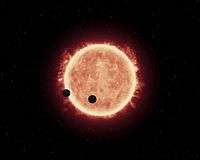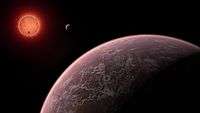TRAPPIST-1b
| Exoplanet | List of exoplanets | |
|---|---|---|
| Parent star | ||
| Star | TRAPPIST-1[1] | |
| Spectral type | M8[1][2]:1236 | |
| Mass | (m) | 0.08 (± 0.009) (± 0.02)[1] M☉ |
| Radius | (r) | 0.117 (± 0.004)[1] R☉ |
| Temperature | (T) | 2550.0 (± 55.0)[1] K |
| Age | 0.5[1] Gyr | |
| Orbital elements | ||
| Semi-major axis | (a) | 0.01111 (± 0.0004)[1] AU |
| Eccentricity | (e) | 0.0[1] |
| Orbital period | (P) | 1.510848 (± 1.9e-05)[1] Juliean d |
| Inclination | (i) | 89.41 (± 0.41)[1]° |
| Physical characteristics | ||
| Radius | (r) | 0.0993 (± 0.0039) [1] RJ |
| Discovery information | ||
| Discovery date | May 2, 2016 | |
| Discoverer(s) | ||
| Discovery method | Transit | |
| Discovery status | Published | |
TRAPPIST-1b is an exoplanet orbiting around the ultracool dwarf star TRAPPIST-1 approximately 40 light-years away in the constellation Aquarius.
Habitability
During formation of the system it is possible that water loss during pre-HZ periods occurred.[3] Its estimated that TRAPPIST-1b and TRAPPIST-1c may have lost up to four Earth Oceans possibly compromising its habitability, however TRAPPIST-1d may have been able to keep enough liquid water to sustain life.[3]
Spectrum of TRAPPIST-1 b and c
The combined transmission spectrum of TRAPPIST-1 b and c rules out a cloud-free hydrogen-dominated atmosphere for each planet, so they are unlikely to harbor an extended gas envelope. Other atmospheres, from a cloud-free water vapor atmosphere to a Venus-like atmosphere, remain consistent with the featureless spectrum.[4]
Gallery
 Artist's view of planets transiting red dwarf star in TRAPPIST-1 system.[5]
Artist's view of planets transiting red dwarf star in TRAPPIST-1 system.[5] This picture shows the Sun and the ultracool dwarf star TRAPPIST-1 to scale. The faint star has only 11% of the diameter of the Sun and is much redder in colour.
This picture shows the Sun and the ultracool dwarf star TRAPPIST-1 to scale. The faint star has only 11% of the diameter of the Sun and is much redder in colour. This artist's impression shows an imagined view of the three planets orbiting an ultracool dwarf star.
This artist's impression shows an imagined view of the three planets orbiting an ultracool dwarf star. This artist's impression shows an imagined view from the surface one of the three planets orbiting an ultracool dwarf star
This artist's impression shows an imagined view from the surface one of the three planets orbiting an ultracool dwarf star This artist’s impression video shows an imagined view from close to one of the three planets orbiting an ultracool dwarf star just 40 light-years from Earth that were discovered using the TRAPPIST telescope at ESO’s La Silla Observatory. In this view one of the inner planets is seen in transit across the disc of its tiny and dim parent star. (4K Ultra HD Video)
This artist’s impression video shows an imagined view from close to one of the three planets orbiting an ultracool dwarf star just 40 light-years from Earth that were discovered using the TRAPPIST telescope at ESO’s La Silla Observatory. In this view one of the inner planets is seen in transit across the disc of its tiny and dim parent star. (4K Ultra HD Video)
References
- 1 2 3 4 5 6 7 8 9 10 11 "Planet TRAPPIST-1 b". Exoplanet.eu. Retrieved 2016-05-06.
- ↑ Costa, E.; Mendez, R.A.; Jao, W.-C.; Henry, T.J.; Subasavage, J.P.; Ianna, P.A. (August 4, 2006). "The Solar Neighborhood. XVI. Parallaxes from CTIOPI: Final Results from the 1.5 m Telescope Program" (PDF). The Astronomical Journal. The American Astronomical Society. 132 (3): 1234. Bibcode:2006AJ....132.1234C. doi:10.1086/505706.
- 1 2 Bolmont, Emeline; Selsis, Franck; Owen, James E.; Ribas, Ignasi; Raymond, Sean N.; Leconte, Jérémy; Gillon, Michael (2016). "Water loss from Earth-sized planets in the habitable zones of ultracool dwarfs: Implications for the planets of TRAPPIST-1". arXiv:1605.00616
 [astro-ph.EP].
[astro-ph.EP]. - ↑ de Wit, Julien; et al. (2016). "A combined transmission spectrum of the Earth-sized exoplanets TRAPPIST-1 b and c". Preprint. arXiv:1606.01103
 .
. - ↑ "Artist's view of planets transiting red dwarf star in TRAPPIST-1 system". www.spacetelescope.org. Retrieved 21 July 2016.

.jpg)
